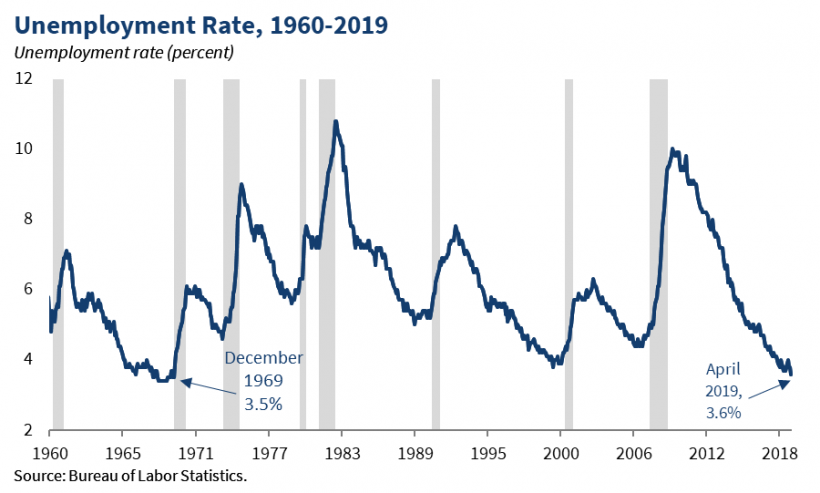The United States economy continued to thrive in April, with the unemployment rate dropping to 3.6 percent—the lowest unemployment rate since December 1969, according to the Bureau of Labor Statistics’ (BLS) household survey. April also marks the 14th consecutive month of the unemployment rate being at or below 4 percent.
The rapidly growing economy continues to benefit a wide range of demographic groups. The unemployment rate for adult women (20+) reached 3.1 percent in April, its lowest rate since 1953. The unemployment rate for Hispanics fell to 4.2 percent—the lowest rate since the series began in 1973. The unemployment rate for individuals with only a high school degree fell to 3.5 percent—matching the lowest rate since 2000. The unemployment rate for those with a disability fell to 6.3 percent in April—the lowest rate since the series began in 2008. Additionally, the unemployment rate for veterans fell to 2.3 percent—the lowest rate since the series began in 2000.

The U-6 unemployment rate, a broader measure of unemployment that includes those who are unemployed, marginally attached to the labor force, and working part-time for economic reasons, remained at 7.3 percent in April, matching the lowest U-6 rate since December 2000.
A separate survey from BLS, the Employment Situation Report, showed total nonfarm payroll employment in April rose by 263,000 jobs, far surpassing market expectations (190,000). In total, the economy has added over 5.8 million jobs since President Donald J. Trump was elected. The month of April continued the longest streak of growth on record.
Employment gains have exceeded 100,000 jobs in 27 of the 29 months since the 2016 election. Including revisions for the months of February and March, the average pace of job growth has been a healthy 218,000 jobs per month over the past year and 205,000 jobs per month so far in 2019. Job gains were predominantly concentrated in professional and business services (76,000 new jobs), education and health services (62,000 new jobs), and leisure and hospitality (34,000 new jobs). The construction sector added 33,000 new jobs in April, and has added 669,000 jobs since the 2016 election.
On top of the good news about job growth, the report indicates that wages are rising, too. Nominal average hourly earnings in April rose by 3.2 percent over the past 12 months, marking the 9th straight month that year-over-year wage gains were at or above 3 percent. Prior to 2018, nominal average hourly wage gains had not reached 3 percent since April 2009. Taking inflation into account, there is more evidence that real wages are also growing. Based on the most recent Personal Consumption Expenditures (PCE) price index data from March, inflation in the past year was 1.5 percent, and, based on the most recent Consumer Price Index (CPI-U) price data from March, inflation in the past year was 1.9 percent. This offers evidence that real wages are rising, and people are able to purchase more goods and services with their larger paychecks.
These most recent BLS surveys depict a strong American economy. Employment growth in April surpassed expectations with 263,000 new jobs, while the unemployment rate of 3.6 percent is the lowest rate in nearly half a century. With continued positive job growth, sustained low unemployment, and rising real wages, the economy continues to thrive.
